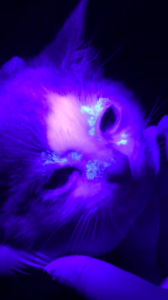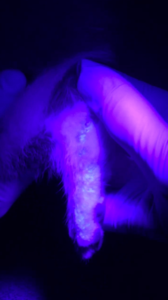Despite its name, ringworm (dermatophytosis) is a fungal infection, not a type of parasitic worm. It is caused by several species of fungi called dermatophytes that infect the outer layers of the skin and hair. Ringworm is zoonotic, this means that it can be transmitted between people and animals. Left untreated, ringworm can cause painful and uncomfortable symptoms in people and pets.
Causes of Ringworm
Ringworm can be contracted in a number of ways. These include exposure to an infected animal, mutual grooming, and contact with contaminated items such as bedding and grooming tools. Animals can also come into contact with dermatophytes that live in the soil. Pets with compromised or underdeveloped immune systems are particularly prone to ringworm infection. Other risk factors include humid environments, poor nutrition, and open wounds.
Symptoms of Ringworm
Please be aware that symptoms of ringworm can vary between animals, and some pets may show no obvious signs of infection. Please visit your veterinarian immediately if your pet displays any of the following common symptoms of ringworm to prevent the spread of infection.
- Skin lesions
- Patches of hair loss
- Brittle coat
- Scaly skin
- Skin redness and irritation
- Dandruff
- Brittle or broken claws
Diagnosis of Ringworm
Your veterinarian will assess your pet’s medical history and ask you a series of questions about the onset of their symptoms. They will then perform a thorough physical examination to check for clinical signs of ringworm infection.
Since some types of fungus fluoresce under ultraviolet light, a Wood’s lamp examination may be performed to help reach a diagnosis. Microscopic analysis of hair samples can also help your veterinarian identify ringworm infection. If a definitive diagnosis is needed, a sample of hair will be sent to a laboratory for fungal culture testing.
Treatment of Ringworm
Ringworm infection is routinely treated with antifungal medications. These may be administered orally or applied topically in the form of shampoos, ointments, or creams. In some cases, it will be necessary to trim your pet’s fur before using topical treatments.
Treatment for ringworm infection will often need to be continued for a period of at least six weeks. It will also be necessary to isolate infected animals and thoroughly clean your home to eradicate fungal spores. Please follow your veterinarian’s advice closely and administer all medications as instructed.
Prevention of Ringworm
Since ringworm can be contracted from various sources, the infection can be difficult to prevent. We recommend keeping your pet’s environment clean and avoiding contact with infected animals or contaminated items whenever possible. It’s also important to schedule regular appointments with your veterinarian to assess your pet’s overall health.



